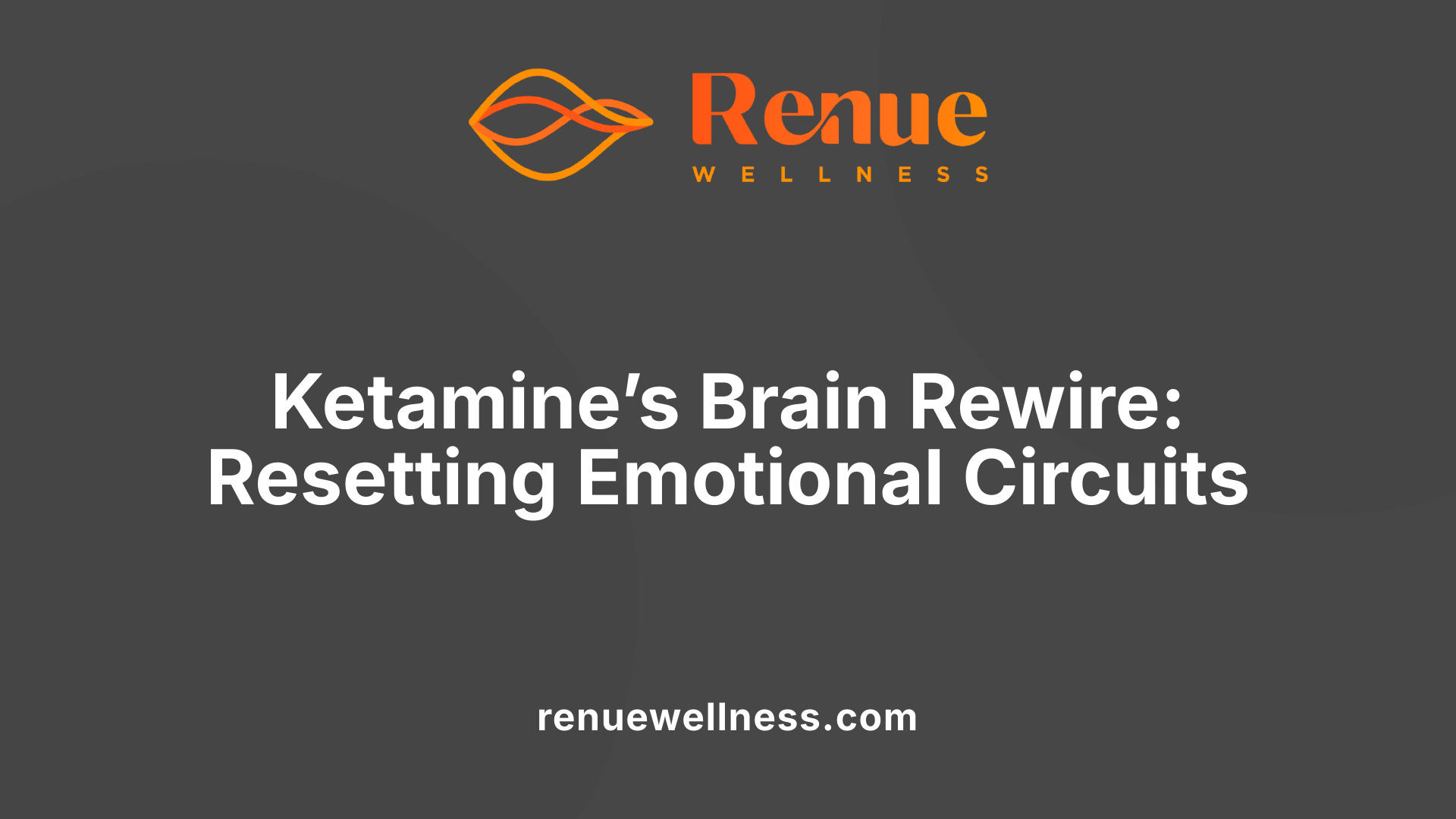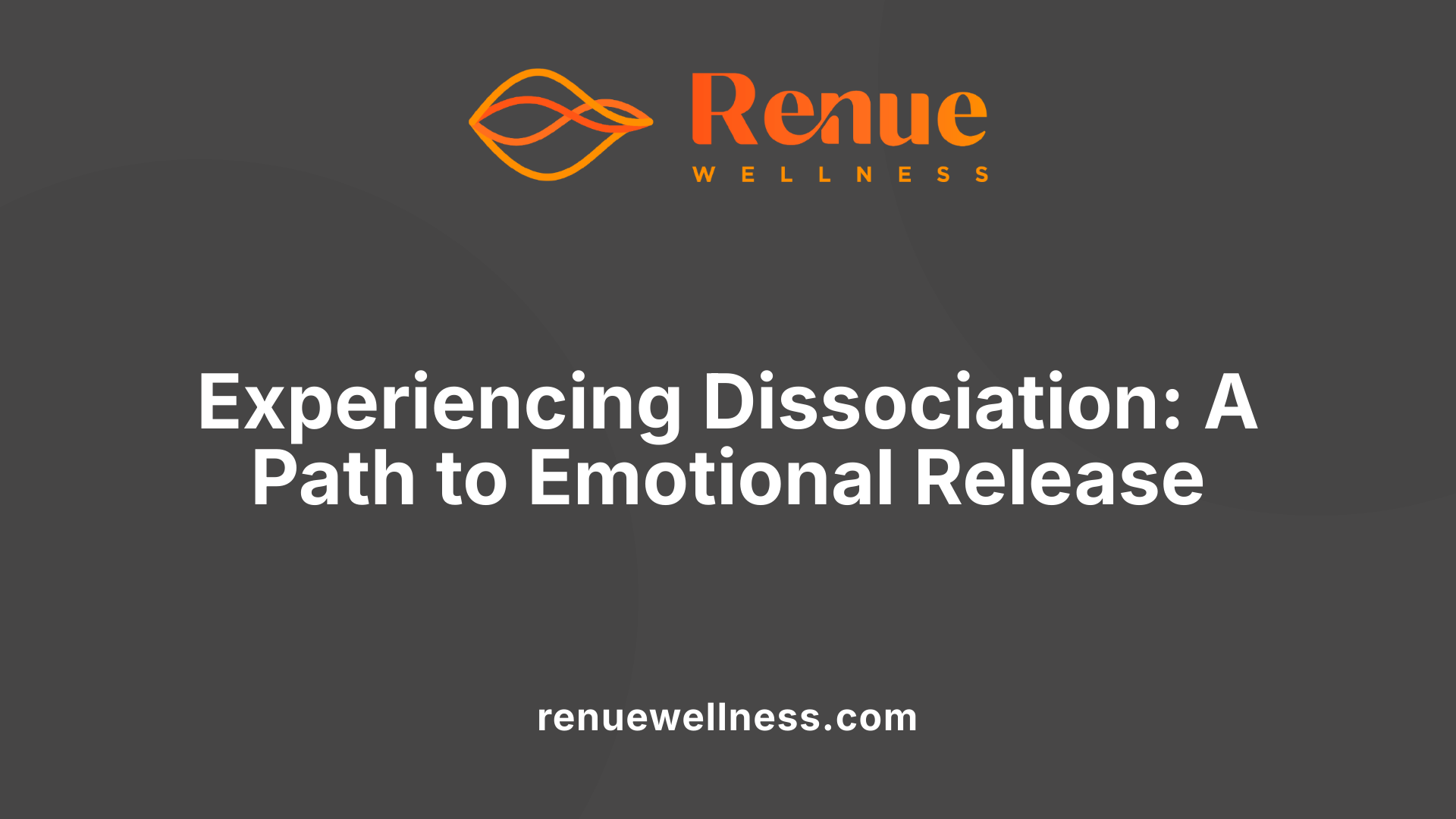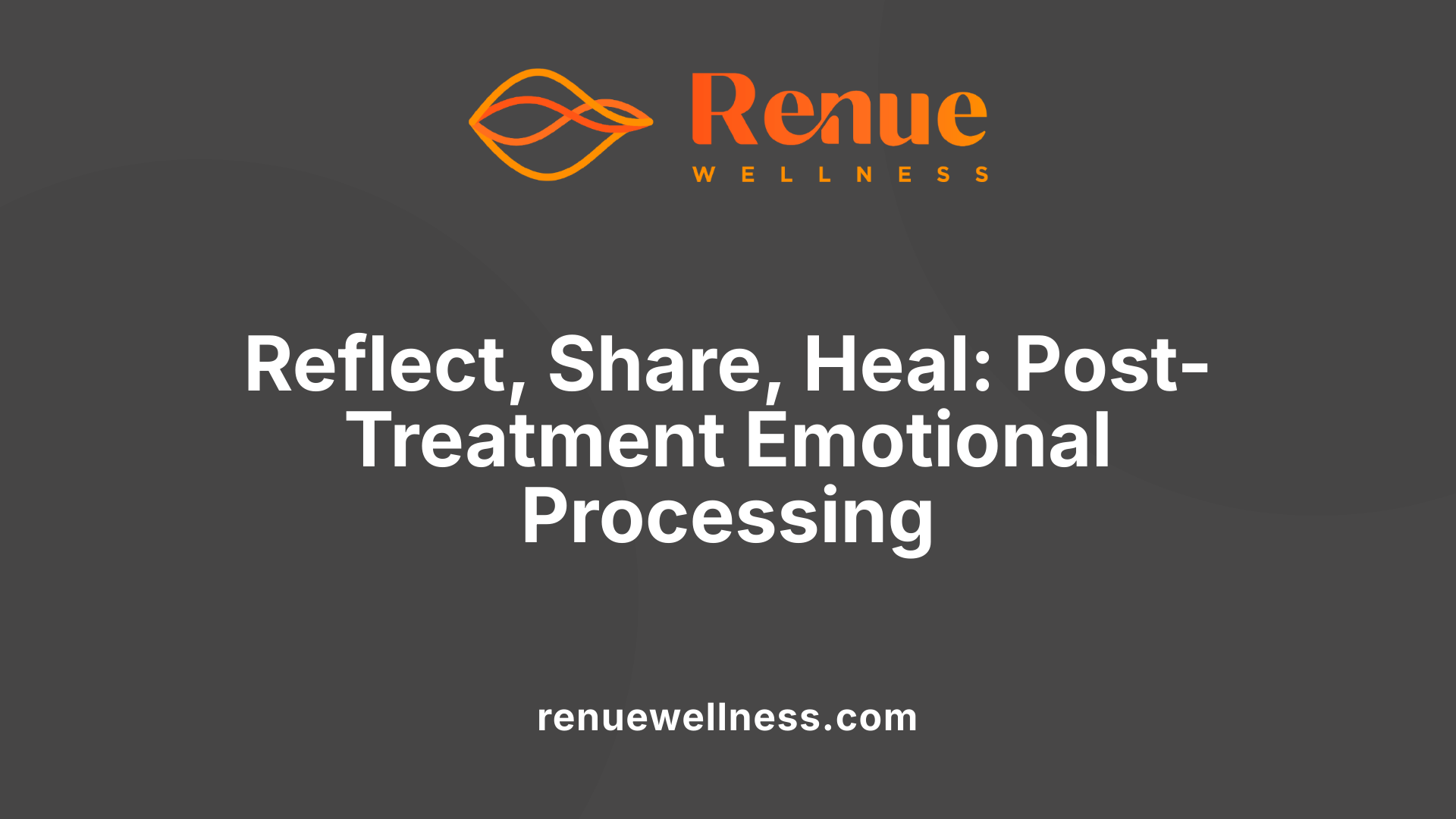Flattened Emotions? Ketamine May Reignite Emotional Response


August 18, 2025
Understanding Ketamine’s Role in Emotional Re-engagement
Recent scientific studies and clinical experiences reveal that ketamine, widely recognized for its rapid antidepressant effects, also holds promise in reigniting suppressed or dulled emotional responses. This article explores how ketamine influences brain function, facilitates emotional release, and supports emotional healing, providing a new perspective on mental health treatment.
Neurobiological Impact of Ketamine on Emotional Processing

How does ketamine affect emotional responses, including unfreezing or rekindling suppressed feelings?
Ketamine influences emotional responses by acting on vital brain regions involved in how we process feelings, such as the prefrontal cortex, limbic system, and anterior cingulate cortex. It tends to decrease overactivity in areas linked to negative emotions and persistent rumination, like parts of the hippocampus and the default mode network. This neural modulation helps normalize disrupted activity patterns common in depression.
During ketamine-assisted therapy, this effect enables suppressed or traumatic emotions to surface more easily. Patients often experience emotional release, a sense of peace, or calm. Difficult feelings—such as sadness or anxiety—may emerge, providing an opportunity for reflection and emotional insight. This process supports unlocking emotions previously suppressed or avoided, encouraging healing and understanding.
Ultimately, ketamine helps unfreeze and rekindle suppressed feelings by easing the neural barriers that keep these emotions hidden. This can lead to therapeutic breakthroughs, fostering long-term emotional recovery and resilience, especially in treatment-resistant depression.
What scientific evidence exists regarding ketamine's influence on emotional processing and normalization?
Research using functional MRI (fMRI) has provided clear evidence of ketamine's impact on brain regions involved in emotional regulation. Studies reveal that after ketamine administration, neural activity in areas such as the anterior cingulate cortex, insula, hippocampus, and the default mode network decreases in individuals with depression.
This decrease in hyperactivity signifies a movement toward normalized brain function, aligning the activity levels of depressed patients more closely with healthy controls. This process is often called neural normalization.
Furthermore, ketamine influences circuits related to negative emotions by modulating glutamatergic transmission. It enhances connectivity between the prefrontal cortex and limbic areas, reducing emotional reactivity and distress.
The rapid antidepressant effects observed with ketamine are consistent with these neural changes. They suggest that ketamine’s therapeutic action involves directly altering dysfunctional neural circuits involved in mood regulation and emotional processing.
Brain regions involved in emotional regulation (prefrontal cortex, limbic areas, anterior cingulate cortex)
| Brain Region | Function in Emotional Processing | Effect of Ketamine | Related Changes in Depression |
|---|---|---|---|
| Prefrontal Cortex | Executive function, emotion regulation | Increased activity post-treatment | Decreased hyperactivity leads to better regulation |
| Limbic Areas (including hippocampus) | Memory, emotional response, negative emotion regulation | Reduced hyperactivity | Normalization reduces negative ruminations |
| Anterior Cingulate Cortex | Conflict monitoring, emotion regulation | Decreased activity | Reduces emotional dysregulation |
Decrease in hyperactivity in brain regions linked to negative emotions
In individuals with depression, hyperactivity in brain regions associated with negative emotions and rumination is common. Ketamine induces a marked reduction in activity within these areas, including the hippocampus and parts of the default mode network. This reduction is linked to alleviation of depressive symptoms as the brain moves toward more balanced activity levels.
Normalization of brain activity patterns in depression
The most significant neurobiological effect of ketamine is its ability to normalize aberrant brain activity patterns. Prior to treatment, depressed patients show heightened activity in emotion-related regions. Post-ketamine, this activity decreases, aligning more closely with patterns observed in healthy individuals. This normalization process is associated with rapid mood improvements and suggests that ketamine acts to restore healthy neural function.
Effects during explicit vs. implicit emotional processing
Ketamine’s influence differs depending on whether the emotional processing task is explicit (deliberate recognition of emotion) or implicit (automatic emotional response). Studies show that after ketamine, brain activity in depressed patients during emotional tasks resembles that of healthy controls, particularly in regions like the anterior cingulate and prefrontal cortex.
In explicit tasks, ketamine tends to reduce hyperactivation, whereas in implicit tasks, it helps in normalizing automatic emotional responses. These effects support the idea that ketamine facilitates both conscious and subconscious emotional regulation, contributing to its antidepressant efficacy.
| Processing Type | Effect of Ketamine | Brain Regions Affected | Therapeutic Implication |
|---|---|---|---|
| Explicit | Decreased hyperactivity, normalized activity in emotion regulation circuits | Prefrontal cortex, anterior cingulate | Enhances conscious emotional regulation |
| Implicit | Restores automatic emotional responses, reduces abnormal reactivity | Limbic system, insula | Promotes automatic emotional resilience |
This neurobiological foundation underscores ketamine’s ability to modulate and normalize neural circuits involved in emotion, providing a potent mechanism for rapid symptom relief in treatment-resistant depression.
Dissociation and Emotional Shifts During Treatment

What are the features of ketamine-induced dissociation, including detachment and perceptual distortions?
During ketamine therapy, patients typically experience a state of dissociation characterized by a vivid sense of detachment from their surroundings, body, and even their sense of self. This profound disconnect often begins shortly after administration and can last from several minutes to hours, depending on the dosage. Physically, patients may report numbness, heaviness, or limbs feeling disconnected. They often describe sensations of floating, feeling weightless, or observing themselves from an outside perspective. Visual and auditory distortions are common, including seeing colors more vividly, experiencing hallucinations, and perceiving sounds or visual cues differently. Some individuals experience referential or dream-like thoughts, which may serve to facilitate emotional processing. These perceptual changes are not typically distressing in a controlled therapeutic setting and are seen as part of the brain's response to ketamine.'}
What are common emotional experiences during dissociation, such as floating sensations and perception distortions?
Many patients report experiencing intense emotional shifts during dissociative states induced by ketamine. A common sensation is the feeling of floating or being weightless, which can contribute to a sense of calm or detachment from stressful thoughts. Visual and auditory distortions, such as seeing vibrant colors or hearing muffled sounds, often accompany feelings of relaxation, joy, or sometimes sadness. Some individuals experience visual imagery ranging from gentle, flowing visuals to vivid hallucinations. These altered perceptions can evoke deep emotional responses, including feelings of awe, joy, or sadness. Such emotional experiences serve as a gateway for accessing suppressed feelings or memories, enabling emotional release and insight. For many, these shifts foster a sense of connection to their inner emotional landscape, paving the way for therapeutic breakthroughs.
How do effects on mood, including euphoria and sadness, manifest during treatment?
Mood changes during ketamine-induced dissociation are varied and often transient. Euphoria or a feeling of happiness can arise during or after sessions, sometimes uncovering joyful memories or inspiring feelings of hope. Conversely, some individuals may experience a temporary wave of sadness, grief, or despair as difficult emotions surface amid dissociative states. These mood fluctuations are often part of the natural emotional processing stimulated by ketamine, allowing individuals to confront and work through emotions that may be suppressed or deep-seated. It is important for therapists to monitor these emotional shifts to support patients through their experiences, ensuring that feelings are processed healthily and integrating insights gained during therapy.
What are perceptions of time and space, and how are they relevant to therapy?
Alterations in perceptions of time and space are typical during ketamine dissociation. Many patients report that time feels slowed down, faster, or even non-existent during their experience. Spatial perceptions can also change, with some feeling as if they are outside their body or observing their surroundings from a different vantage point. These perceptual shifts can help patients dissociate from their usual mental and emotional patterns, providing a psychological buffer and promoting openness to new perspectives. Therapeutically, such experiences can reduce fear and resistance, allowing patients to explore deep-seated issues with less emotional resistance. The altered perception of time and space often facilitates a sense of expanded consciousness, fostering personal insights and emotional breakthroughs that are central to the healing process during ketamine therapy.
The Role of Emotional Release and Tears in Healing

How do emotional release, crying, and tears during ketamine treatment relate to the healing process?
During ketamine therapy, emotional release, tears, and crying are more than just physical responses; they are vital parts of the healing journey. Ketamine’s ability to dissolve the mental barriers between conscious awareness and subconscious feelings allows suppressed or unresolved emotions to surface.
This surfacing often manifests as crying or emotional releases, which serve as a cathartic process, helping patients gain clarity and relief from emotional burdens. These tears act as an excretory system for feelings, enabling the subconscious to express itself physically.
Recognizing and validating these emotional expressions can deepen the therapeutic impact. Tears, whether of joy, relief, or sorrow, are seen as a natural and essential component of emotional cleansing. They facilitate a pathway toward emotional integration, helping patients process difficult memories or feelings that may have been repressed.
Post-session, engaging in reflection, discussion, or creative outlets can support this emotional processing. Such activities help incorporate the insights gained during sessions, fostering long-term emotional resilience and healing.
Overall, tears and emotional release during ketamine therapy are signs of a profound internal transformation, guiding patients toward emotional clarity and recovery.
Facilitating Emotional Healing Through Reflection and Support

How does post-session emotional processing, including sharing experiences with therapists or through self-reflection, support emotional healing?
Post-session emotional processing is a crucial aspect of the healing journey after ketamine therapy. During sessions, many patients experience intense emotions, often surfacing as tears or deep feelings of sadness, joy, or relief. Discussing these emotional releases with a supportive therapist helps validate and normalize such experiences. This dialogue allows individuals to interpret their feelings, reduce lingering distress, and translate emotional insights into personal growth.
Journaling, artistic expression, or other creative outlets serve as avenues for ongoing emotional expression. These activities assist in consolidating breakthroughs achieved during therapy, ensuring that emotional catharsis leads to stable, positive change.
Moreover, guided emotional integration can foster resilience. When patients process and understand their feelings within a safe, trusting environment, they are better equipped to handle future emotional challenges. This comprehensive approach transforms temporary moments of emotional release into long-term psychological improvements.
The combined effect of reflection, discussion, and creative expression not only supports emotional healing but also empowers individuals to develop a stronger sense of self-awareness and coping skills, enhancing the overall success of ketamine-assisted therapy.
Therapeutic Potential of Ketamine in Emotional Regulation and Mental Health

What is the therapeutic potential of ketamine in mental health treatment related to emotional regulation?
Ketamine has shown promising effects in the treatment of mental health conditions, especially those involving difficulty in managing emotions, such as major depressive disorder (MDD) and trauma-related disorders. Its rapid action on brain circuits involved in emotional processing enables quick symptom relief for patients resistant to traditional therapies.
Research indicates that ketamine influences several brain regions, including limbic areas like the amygdala and hippocampus, which are vital for processing emotions and memories. After administration, there is a notable decrease in activity within these regions, reducing hyperactivity linked to negative mood states and emotional distress. For example, functional MRI studies reveal that ketamine diminishes activity in the default mode network (DMN)—a network associated with internal thoughts and rumination often heightened in depression.
In addition to dampening hyperactive areas, ketamine helps normalize activity in the anterior cingulate cortex and medial frontal cortex, regions crucial for emotional regulation and attentional control. By doing so, it reduces the dominance of negative thought patterns and enhances emotional flexibility.
A remarkable aspect of ketamine's effect is its ability to stimulate neuroplasticity— the brain's capacity to reorganize and form new neural connections. This rewiring allows maladaptive circuits related to fear, avoidance, and rumination to be reshaped into healthier pathways, fostering better emotional responses.
Furthermore, ketamine’s influence extends beyond chemical modulation; it invites a restructuring of neural circuits that govern emotional reactions. This reorganization can lead to increased emotional responsiveness, resilience, and the ability to confront and process challenging feelings more adaptively.
During therapy, patients often experience emotional releases—such as crying—which are viewed as a physical expression of suppressed emotions surfacing. Recognizing tears as an 'emotional excretory system' can help validate these experiences and foster trust in the therapeutic process.
In summary, ketamine’s rapid modulation of brain activity and its promotion of neuroplasticity make it a powerful tool for emotional regulation. It not only alleviates acute symptoms but also supports long-term neural rewiring, enabling individuals to develop healthier coping mechanisms, reduce avoidance behaviors, and improve overall emotional resilience.
A New Hope for Emotional Reconnection
As research deepens and clinical practices evolve, ketamine's unique ability to dissolve mental barriers and reignite emotional responses offers new hope for those battling emotional numbness and psychological suffering. By fostering emotional release, supporting the processing of difficult feelings, and promoting brain normalization, ketamine therapy can unlock hidden depths of feeling, ultimately paving the way for renewed emotional resilience and healing.
References
- Effects of ketamine on brain activity during emotional processing
- Why You Are Crying During Ketamine Therapy
- Why Your Patient Is Crying During Ketamine Treatments
- Ketamine Patients Describe the Dissociative Experience
- Ketamine normalizes brain activity during emotionally valenced ...
- What Does the Ketamine Therapy Experience Actually Feel Like?
- Effects of ketamine on brain activity during emotional processing
- Ketamine normalizes brain activity during emotionally valenced ...
Recent Posts
Conditions Treated
AnxietyDepressionOCDPTSDPostpartum DepressionPain ManagementSubstance AbuseSuicidal IdeationOur Location


